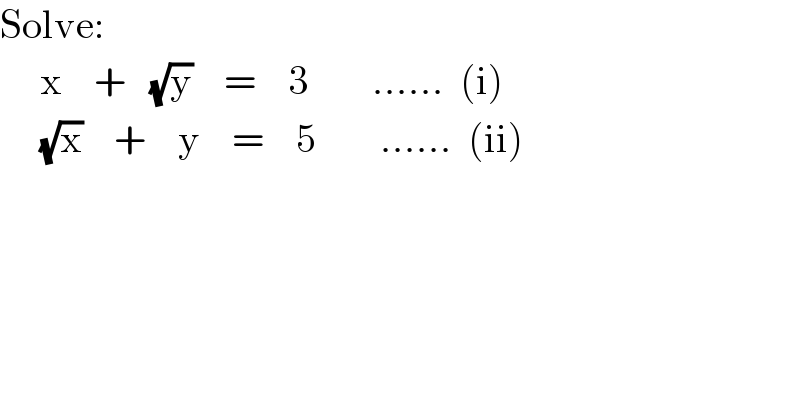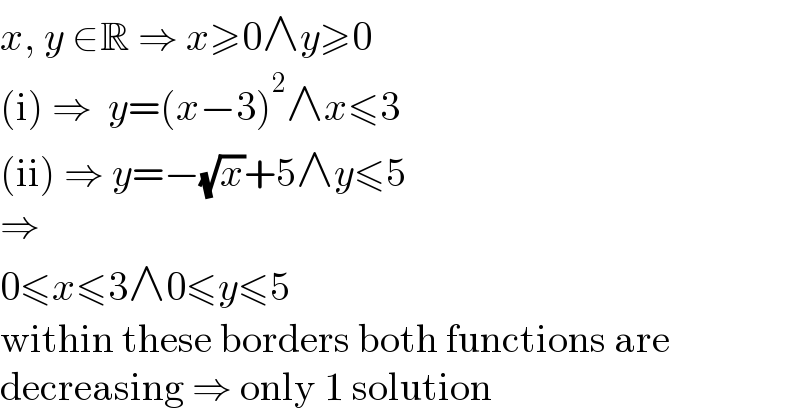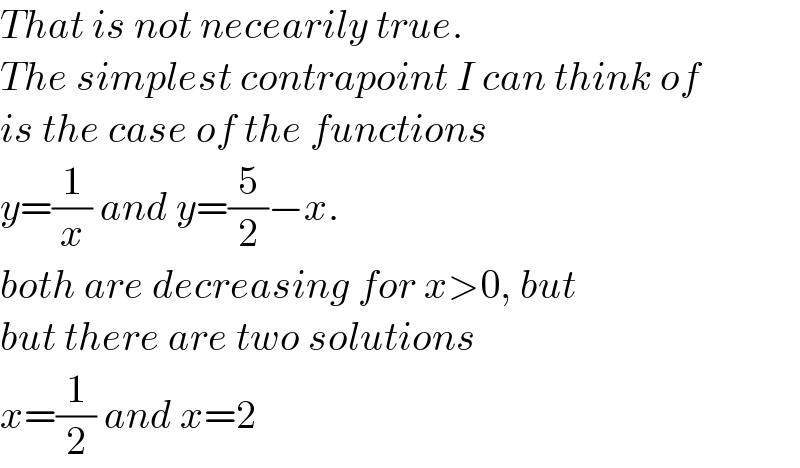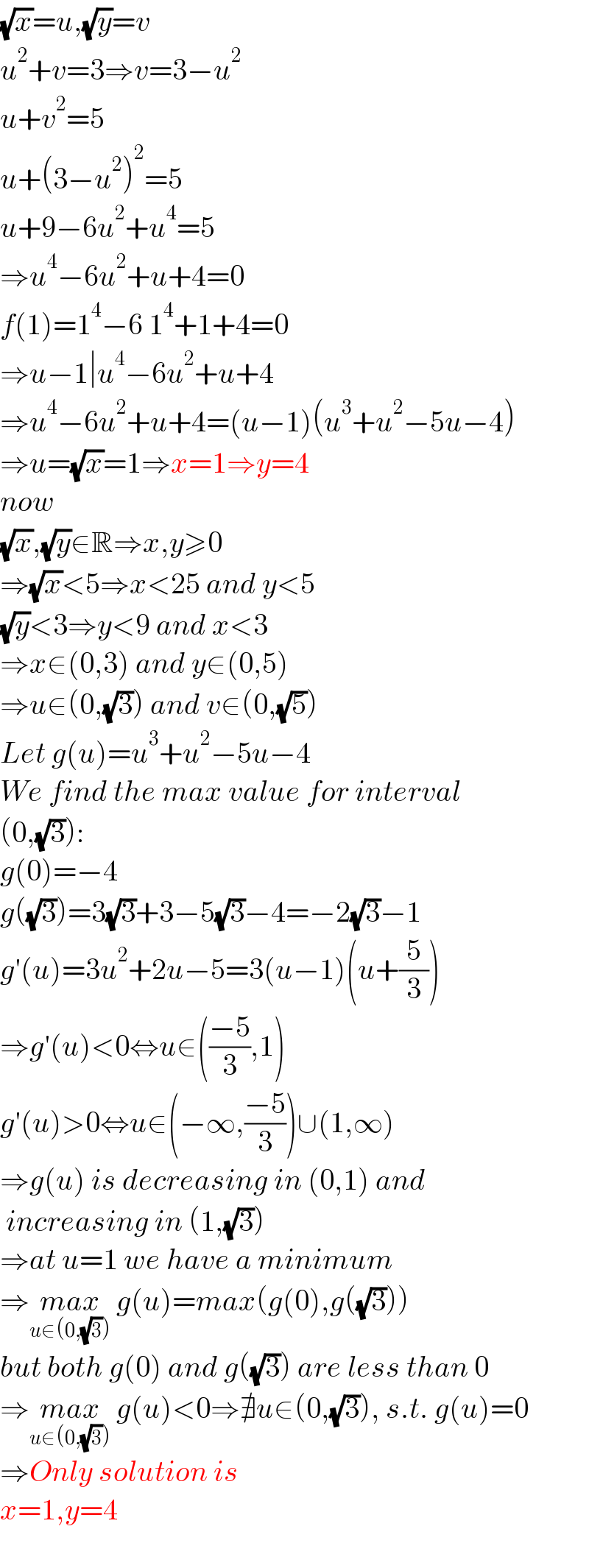Question Number 170754 by Tawa11 last updated on 30/May/22

$$\mathrm{Solve}: \\ $$$$\:\:\:\:\:\mathrm{x}\:\:\:\:+\:\:\:\sqrt{\mathrm{y}}\:\:\:\:=\:\:\:\:\mathrm{3}\:\:\:\:\:\:\:\:……\:\:\left(\mathrm{i}\right) \\ $$$$\:\:\:\:\:\sqrt{\mathrm{x}}\:\:\:\:+\:\:\:\:\mathrm{y}\:\:\:\:=\:\:\:\:\mathrm{5}\:\:\:\:\:\:\:\:……\:\:\left(\mathrm{ii}\right) \\ $$
Commented by MJS_new last updated on 30/May/22

$$\mathrm{obviously}\:{x}=\mathrm{1}\wedge{y}=\mathrm{4} \\ $$
Commented by aleks041103 last updated on 30/May/22

$${And}\:{yet}\:{not}\:{obvious}\:{if}\:{it}\:{is}\:{the}\:{only}\:{solution} \\ $$
Commented by MJS_new last updated on 30/May/22

$${x},\:{y}\:\in\mathbb{R}\:\Rightarrow\:{x}\geqslant\mathrm{0}\wedge{y}\geqslant\mathrm{0} \\ $$$$\left(\mathrm{i}\right)\:\Rightarrow\:\:{y}=\left({x}−\mathrm{3}\right)^{\mathrm{2}} \wedge{x}\leqslant\mathrm{3} \\ $$$$\left(\mathrm{ii}\right)\:\Rightarrow\:{y}=−\sqrt{{x}}+\mathrm{5}\wedge{y}\leqslant\mathrm{5} \\ $$$$\Rightarrow \\ $$$$\mathrm{0}\leqslant{x}\leqslant\mathrm{3}\wedge\mathrm{0}\leqslant{y}\leqslant\mathrm{5} \\ $$$$\mathrm{within}\:\mathrm{these}\:\mathrm{borders}\:\mathrm{both}\:\mathrm{functions}\:\mathrm{are} \\ $$$$\mathrm{decreasing}\:\Rightarrow\:\mathrm{only}\:\mathrm{1}\:\mathrm{solution} \\ $$
Commented by aleks041103 last updated on 30/May/22

$${That}\:{is}\:{not}\:{necearily}\:{true}. \\ $$$${The}\:{simplest}\:{contrapoint}\:{I}\:{can}\:{think}\:{of} \\ $$$${is}\:{the}\:{case}\:{of}\:{the}\:{functions} \\ $$$${y}=\frac{\mathrm{1}}{{x}}\:{and}\:{y}=\frac{\mathrm{5}}{\mathrm{2}}−{x}. \\ $$$${both}\:{are}\:{decreasing}\:{for}\:{x}>\mathrm{0},\:{but} \\ $$$${but}\:{there}\:{are}\:{two}\:{solutions} \\ $$$${x}=\frac{\mathrm{1}}{\mathrm{2}}\:{and}\:{x}=\mathrm{2} \\ $$
Commented by Tawa11 last updated on 30/May/22

$$\mathrm{I}\:\mathrm{appreciate}\:\mathrm{sir} \\ $$
Answered by aleks041103 last updated on 30/May/22

$$\sqrt{{x}}={u},\sqrt{{y}}={v} \\ $$$${u}^{\mathrm{2}} +{v}=\mathrm{3}\Rightarrow{v}=\mathrm{3}−{u}^{\mathrm{2}} \\ $$$${u}+{v}^{\mathrm{2}} =\mathrm{5} \\ $$$${u}+\left(\mathrm{3}−{u}^{\mathrm{2}} \right)^{\mathrm{2}} =\mathrm{5} \\ $$$${u}+\mathrm{9}−\mathrm{6}{u}^{\mathrm{2}} +{u}^{\mathrm{4}} =\mathrm{5} \\ $$$$\Rightarrow{u}^{\mathrm{4}} −\mathrm{6}{u}^{\mathrm{2}} +{u}+\mathrm{4}=\mathrm{0} \\ $$$${f}\left(\mathrm{1}\right)=\mathrm{1}^{\mathrm{4}} −\mathrm{6}\:\mathrm{1}^{\mathrm{4}} +\mathrm{1}+\mathrm{4}=\mathrm{0} \\ $$$$\Rightarrow{u}−\mathrm{1}\mid{u}^{\mathrm{4}} −\mathrm{6}{u}^{\mathrm{2}} +{u}+\mathrm{4} \\ $$$$\Rightarrow{u}^{\mathrm{4}} −\mathrm{6}{u}^{\mathrm{2}} +{u}+\mathrm{4}=\left({u}−\mathrm{1}\right)\left({u}^{\mathrm{3}} +{u}^{\mathrm{2}} −\mathrm{5}{u}−\mathrm{4}\right) \\ $$$$\Rightarrow{u}=\sqrt{{x}}=\mathrm{1}\Rightarrow{x}=\mathrm{1}\Rightarrow{y}=\mathrm{4} \\ $$$${now} \\ $$$$\sqrt{{x}},\sqrt{{y}}\in\mathbb{R}\Rightarrow{x},{y}\geqslant\mathrm{0} \\ $$$$\Rightarrow\sqrt{{x}}<\mathrm{5}\Rightarrow{x}<\mathrm{25}\:{and}\:{y}<\mathrm{5} \\ $$$$\sqrt{{y}}<\mathrm{3}\Rightarrow{y}<\mathrm{9}\:{and}\:{x}<\mathrm{3} \\ $$$$\Rightarrow{x}\in\left(\mathrm{0},\mathrm{3}\right)\:{and}\:{y}\in\left(\mathrm{0},\mathrm{5}\right) \\ $$$$\Rightarrow{u}\in\left(\mathrm{0},\sqrt{\mathrm{3}}\right)\:{and}\:{v}\in\left(\mathrm{0},\sqrt{\mathrm{5}}\right) \\ $$$${Let}\:{g}\left({u}\right)={u}^{\mathrm{3}} +{u}^{\mathrm{2}} −\mathrm{5}{u}−\mathrm{4} \\ $$$${We}\:{find}\:{the}\:{max}\:{value}\:{for}\:{interval} \\ $$$$\left(\mathrm{0},\sqrt{\mathrm{3}}\right): \\ $$$${g}\left(\mathrm{0}\right)=−\mathrm{4} \\ $$$${g}\left(\sqrt{\mathrm{3}}\right)=\mathrm{3}\sqrt{\mathrm{3}}+\mathrm{3}−\mathrm{5}\sqrt{\mathrm{3}}−\mathrm{4}=−\mathrm{2}\sqrt{\mathrm{3}}−\mathrm{1} \\ $$$${g}'\left({u}\right)=\mathrm{3}{u}^{\mathrm{2}} +\mathrm{2}{u}−\mathrm{5}=\mathrm{3}\left({u}−\mathrm{1}\right)\left({u}+\frac{\mathrm{5}}{\mathrm{3}}\right) \\ $$$$\Rightarrow{g}'\left({u}\right)<\mathrm{0}\Leftrightarrow{u}\in\left(\frac{−\mathrm{5}}{\mathrm{3}},\mathrm{1}\right) \\ $$$${g}'\left({u}\right)>\mathrm{0}\Leftrightarrow{u}\in\left(−\infty,\frac{−\mathrm{5}}{\mathrm{3}}\right)\cup\left(\mathrm{1},\infty\right) \\ $$$$\Rightarrow{g}\left({u}\right)\:{is}\:{decreasing}\:{in}\:\left(\mathrm{0},\mathrm{1}\right)\:{and} \\ $$$$\:{increasing}\:{in}\:\left(\mathrm{1},\sqrt{\mathrm{3}}\right) \\ $$$$\Rightarrow{at}\:{u}=\mathrm{1}\:{we}\:{have}\:{a}\:{minimum} \\ $$$$\Rightarrow\underset{{u}\in\left(\mathrm{0},\sqrt{\mathrm{3}}\right)} {{max}}\:{g}\left({u}\right)={max}\left({g}\left(\mathrm{0}\right),{g}\left(\sqrt{\mathrm{3}}\right)\right) \\ $$$${but}\:{both}\:{g}\left(\mathrm{0}\right)\:{and}\:{g}\left(\sqrt{\mathrm{3}}\right)\:{are}\:{less}\:{than}\:\mathrm{0} \\ $$$$\Rightarrow\underset{{u}\in\left(\mathrm{0},\sqrt{\mathrm{3}}\right)} {{max}}\:{g}\left({u}\right)<\mathrm{0}\Rightarrow\nexists{u}\in\left(\mathrm{0},\sqrt{\mathrm{3}}\right),\:{s}.{t}.\:{g}\left({u}\right)=\mathrm{0} \\ $$$$\Rightarrow{Only}\:{solution}\:{is} \\ $$$${x}=\mathrm{1},{y}=\mathrm{4} \\ $$$$ \\ $$
Commented by Tawa11 last updated on 30/May/22

$$\mathrm{I}\:\mathrm{appreciate}\:\mathrm{sir} \\ $$
